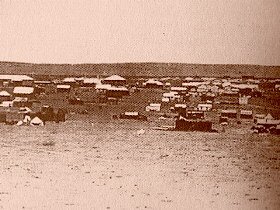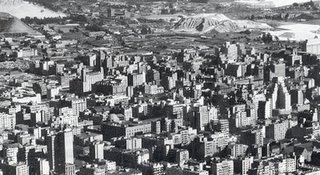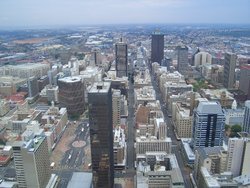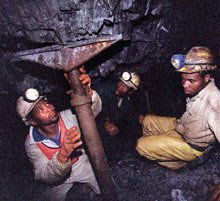Nowhere is the vastness of the mineral wealth which has been drained from the African continent more apparent than in Johannesburg. The native name for the city - “gauteng” means “city of gold”. Of the metal estimated to have been mined in the world to date, around half has come from Africa, and the bulk of that has been from the nation of South Africa. It has been and remains the world's largest producer of both gold and diamonds. Its landscape is still littered with man-made mountains of mine waste and the hulking machinery of depleted mine-shafts. The demands of the mining companies for a guaranteed supply of permanently cheap black unskilled labor led to the legalized framework of racial discrimination. The origins of apartheid lays in large part in the mines and the lure of gold.
 At the beginning of 1886 the undistinguished stretch of Transvaal highveld that would become Johannesburg was nothing more than open plains and sparsely settled farmland. All that would change when George Harrison, an Australian prospector, stumbled on the only surface outcrop of the richest gold-bearing reef in the world. Within months droves of diggers descended on the site, and a tent city was erected. Because the gold was deep and in reef form, not the easily accessible alluvial form, mining required heavy equipment, so mines were quickly concentrated in the hands of men who had the capital to finance large underground operations. From there the city of Johannesburg sprung up and is today the largest economic hub in all of Africa.
At the beginning of 1886 the undistinguished stretch of Transvaal highveld that would become Johannesburg was nothing more than open plains and sparsely settled farmland. All that would change when George Harrison, an Australian prospector, stumbled on the only surface outcrop of the richest gold-bearing reef in the world. Within months droves of diggers descended on the site, and a tent city was erected. Because the gold was deep and in reef form, not the easily accessible alluvial form, mining required heavy equipment, so mines were quickly concentrated in the hands of men who had the capital to finance large underground operations. From there the city of Johannesburg sprung up and is today the largest economic hub in all of Africa.

 Though their conditions have been much improved miners in South Africa still do not have a life to be envied. Most begin their day by climbing into the metal cages that will take them deep into the belly of the earth where they will spend there shift in one of the narrow shafts that run as deep as 10,000 feet (nearly 2 miles). At that depth the temperature of the surrounding rock reaches 130°and it is necessary to pump refrigerated air in constantly. During my stay in South Africa the newspapers were filled with coverage of the current mine workers strike.
Though their conditions have been much improved miners in South Africa still do not have a life to be envied. Most begin their day by climbing into the metal cages that will take them deep into the belly of the earth where they will spend there shift in one of the narrow shafts that run as deep as 10,000 feet (nearly 2 miles). At that depth the temperature of the surrounding rock reaches 130°and it is necessary to pump refrigerated air in constantly. During my stay in South Africa the newspapers were filled with coverage of the current mine workers strike.
No comments:
Post a Comment